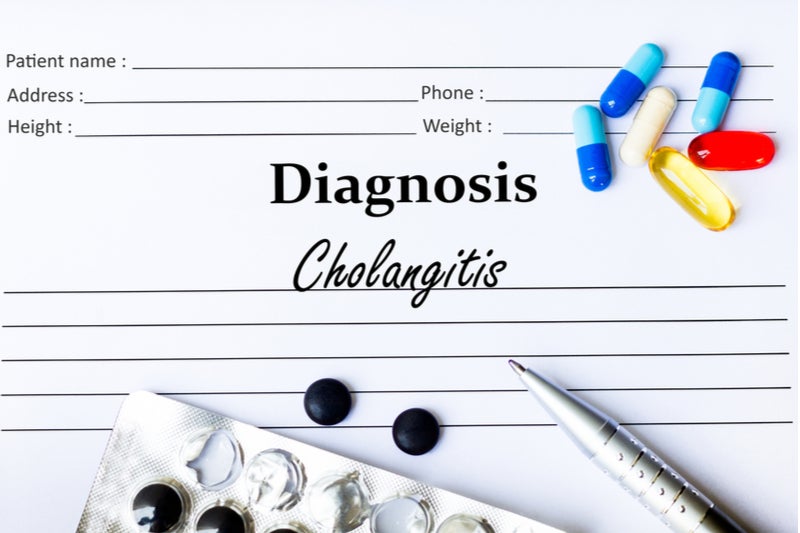Intercept Pharmaceuticals’ future Phase II trial investigating Ocaliva (obeticholic acid) plus generic bezafibrate drew mixed expert reviews as to whether the combination would be better placed as second- (2L) or third-line (3L) primary biliary cholangitis (PBC) therapy.
Regardless, the combination should deliver a 25 to 30 percentage-point superiority over Ocaliva alone to demonstrate efficacy value, experts agreed.
While the combination’s mechanistic rationale and individual monotherapy data are supportive of achieving this benchmark, the Phase II trial will ultimately spell out the combination’s clinical value, they noted. PBC is a long-term, autoimmune condition which affects the liver.
On 7 January, Intercept announced it acquired bezafibrate’s development and commercialisation rights from Aralez Pharmaceuticals with an intention to stage a Phase II PBC trial at an undisclosed date investigating the combination as a fixed-dose regimen. Three analyst reports commended the purchase due to the combination’s ‘yin-yang’ mechanism approach in PBC, but have yet to comment in detail about its potential positioning and what Ocaliva/bezafibrate needs to demonstrate to prove its efficacy.
Intercept has not said in what line it will test the combination. Some experts interviewed on the sidelines of the recent The Liver Meeting in Boston said the combination would be better suited in 3L PBC due to polypharmacy concerns for 2L use. They also said a combination approach may not be needed in 2L if a patient is already responsive to Ocaliva monotherapy. But others noted the combination could reduce Ocaliva’s required dose and thus improve its overall side-effect profile for 2L. Furthermore, 3L positioning would significantly decrease the number of potential patients for an Ocaliva/bezafibrate combination, said one expert.
Still, they agreed the aforementioned 25–30 percentage-point improvements would be a clear efficacy differentiation from Ocaliva monotherapy, which is efficacious in only half of dosed patients. This efficacy rate boost would ensure that new patients experience efficacy apart from the ones already having improvements with Ocaliva alone, they said.
How well do you really know your competitors?
Access the most comprehensive Company Profiles on the market, powered by GlobalData. Save hours of research. Gain competitive edge.

Thank you!
Your download email will arrive shortly
Not ready to buy yet? Download a free sample
We are confident about the unique quality of our Company Profiles. However, we want you to make the most beneficial decision for your business, so we offer a free sample that you can download by submitting the below form
By GlobalDataExperts were in line with analysts noting the combination has a logical rationale, and that bezafibrate monotherapy has an impact in PBC. Bezafibrate could also reduce notable Ocaliva side effects of pruritus and lipid changes, experts noted. Lipid-lowering agent bezafibrate is not FDA- approved but is used ex-US for hyperlipidaemia.
Ocaliva made $117.7m worldwide in 1H19, SEC filings show. Two analyst reports forecast Ocaliva peak sales of $275–567m.
Intercept, which has a $2.7bn market cap, did not respond to a request for comment. Nuvo Pharmaceuticals acquired Aralez in December 2018.
2L and 3L positioning has caveats
At present, it is unclear if Ocaliva/bezafibrate is best suited for 2L use after a patient has failed first-line (1L) generic ursodeoxycholic acid (UDCA) or in 3L after Ocaliva monotherapy, said Dr Richard Manch, director of hepatology, Institute for Liver Health, Tucson, Arizona. Ocaliva locked in FDA approval in PBC in May 2016 as a monotherapy in patients unable to tolerate UDCA, or in combination with UDCA in patients who have an inadequate response to UDCA.
Dr Sonal Kumar, director of clinical hepatology, Weill Cornell Medical College, New York, and Dr Douglas Dieterich, professor, Liver Medicine, Mount Sinai Hospital, New York, said the Ocaliva/bezafibrate combination may be better placed in 3L. This is due to some clinicians’ aversion to polypharmacy, Kumar added. Even if bezafibrate has a tolerable side-effect profile compared with Ocaliva alone, adding it to 2L standard-of-care Ocaliva monotherapy may not be needed if the patient is already responsive to Ocaliva by itself, she added. Stomach upset, stomach pain or gas may occur in the first several days of bezafibrate use, public information shows.
However, a hepatologist said the combination might be better placed in 2L. With combinations, dosing does not need to be as high as when therapy is used as a monotherapy, noted Manch and Dr Jörn Schattenberg, head, metabolic liver disease, University Medical Center, Johannes Gutenberg University, Mainz, Germany. And so, there is the opportunity to reduce Ocaliva’s dose in a combination, which could improve its side-effect profile and would rationalise combination use in 2L, said Schattenberg. Intercept has not yet commented on the Ocaliva dose that will be studied in the Phase II combination study.
Exploring the combination in 3L would significantly put a dent in its potential sales, added Dr Andreas Kremer, clinician-scientist, Faculty of Medicine, Friedrich-Alexander-University of Erlangen-Nürnberg, Germany. As much as 85% of 1L patients respond to UDCA as patients are diagnosed early in the US, leaving 15% who are prescribed 2L Ocaliva, Dieterich added.
25–30 percentage-point range for clinical significance
Nevertheless, to demonstrate clinically significant improvement over Ocaliva monotherapy, the combination should deliver a 25–30 percentage-point response improvement, said Schattenberg and the hepatologist.
Kumar and Dieterich agreed, adding that Ocaliva monotherapy is efficacious in only about half of patients. Ocaliva was FDA-approved based on 216-patient Phase III POISE (NCT01473524) data that showed the primary endpoint occurred in 46% of patients in the 5–10mg Ocaliva group and 47% of patients in the 10mg group versus 10% in the placebo group (p<0.001, Nevens, F, et. al, N Engl J Med. 2016 Aug 18;375(7):631-43). POISE had a composite primary endpoint covering alkaline phosphatase (ALP) and total bilirubin reduction.
It is currently unclear why the other half of patients do not respond to Ocaliva, added Dieterich and Kumar. It could be due to PBC having a disease pathology that is yet to be fully elucidated, said Dieterich and the hepatologist. Ocaliva’s poor side-effect profile could be an impediment to its efficacy, added Kumar. For example, in POISE, pruritus was observed in 56% in the 5–10mg arm (leading to one patient discontinuation) and 68% in the 10mg arm (with seven-patient discontinuation) versus 38% with placebo.
The aforementioned 25–30 percentage-point improvements would mean a noticeable increase in the number of patients who experience efficacy over Ocaliva alone, Kumar said. Dieterich agreed, adding that this range of improvement is a progressive increase from POISE’s response rates. The 25–30 percentage-point range increase would also answer whether the same patients who respond to Ocaliva alone also respond to the combination, Kumar added.
The forthcoming Phase II combination trial is likely to have the same composite primary endpoint seen in POISE, Kumar and Dieterich said. POISE considered patients responsive to therapy when ALP was reduced to less than 1.67 the upper limit of normal at 12 months. While Manch said the ultimate goal is ALP normalisation and not just its reduction under a certain benchmark, Bart Staels, PhD, professor, Faculty of Pharmacy, University of Lille, France, noted normalisation is a high bar that is yet to be convincingly reached by any PBC therapy under investigation.
Since bezafibrate is not available in the US, US-based clinicians would be enthusiastic in joining a future combination trial to access the therapy, Dieterich added.
Combination supported by bezafibrate efficacy/side-effect profile
Nonetheless, the combination rationale behind FXR agonist Ocaliva and pan-PPAR agonist bezafibrate is logical as they have distinct mechanisms to impact PBC, said Dieterich, Kumar and Manch. They impact different signalling pathways that target cholestasis, Kremer and Schattenberg said. PBC is caused by damage to bile ducts in the liver, which leads to bile build-up in the liver.
Bezafibrate monotherapy also has positive data in PBC, supporting a pan-PPAR agonism efficacy rationale, Dieterich and Staels said. In a 100-patient Phase II trial (NCT01654731) investigating bezafibrate monotherapy, the coprimary endpoints of normalisation of ALP and bilirubin were met in 31% with bezafibrate versus 0% with placebo (p<0.001, Corpechot, C, et. al, N Engl J Med. 2018 Jun 7;378(23):2171-2181).
With regards to side effects, an advantage to the combination approach is that bezafibrate is known to have real-world impact in reducing pruritus, which is a notable Ocaliva side effect, Kremer, Schattenberg, Staels and the hepatologist said. It is currently nebulous why Ocaliva causes pruritus, Staels said.
Bezafibrate can also reduce lipids, while Ocaliva has a side effect of lipid increase, Kremer added. Bezafibrate is approved ex-US for hyperlipidaemia, as it can lower LDL-cholesterol and triglyceride in the blood and increase HDL-cholesterol. In POISE, LDL-cholesterol increase was reported in Ocaliva patients compared with placebo, as well as a decrease in HDL-cholesterol.
by Reynald Castaneda in London
Reynald Castaneda is a Senior Reporter for Clinical Trials Arena parent company GlobalData’s investigative journalism team. A version of this article originally appeared on the Insights module of GlobalData’s Pharmaceutical Intelligence Center. To access more articles like this, visit GlobalData.










Related Company Profiles
University Medical Center Corp
Weill Cornell Medical College
Mount Sinai Hospital
3L S.A.
Institute for Liver Health